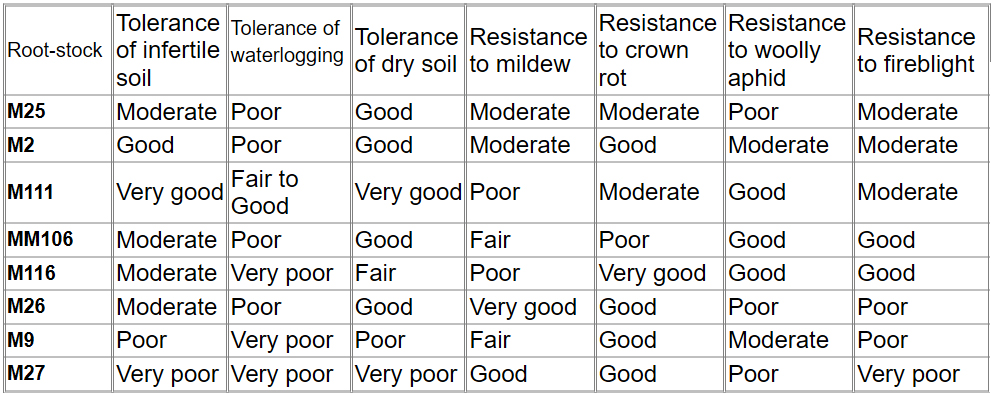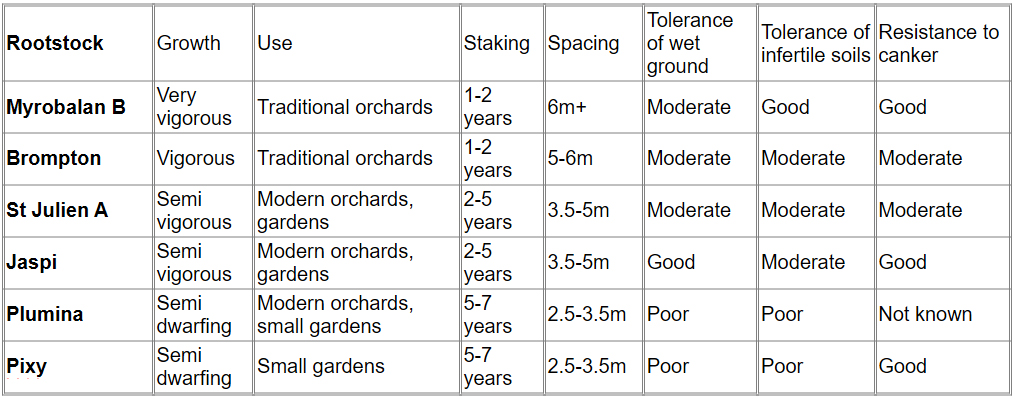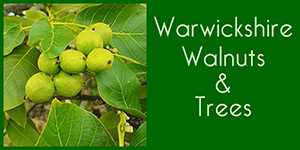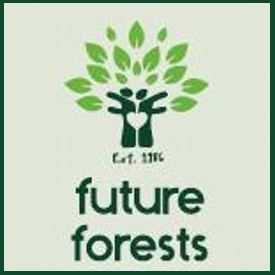Fruit Tree Rootstocks
General Cider and Perry Production in Cidre Review
Find out more about Cider Apple production
Find out more about Perry Pear production
Apple
Almost all fruit trees and a high proportion of nut trees are grafted – that is, the fruiting part of the tree is grafted onto a separate rootstock. The choice of rootstock determines not just the ultimate size of the tree, but also factors such as disease or pest resistance, tolerance of poor ground or climate extremes, precociousness (ability to begin fruiting early in life), longevity, yield and ability to stand alone without long-term staking.
It is very important, therefore, to choose the right rootstock for the right situation. Amazingly, many garden centres sell fruit trees without providing the buyer with information about the rootstock – this could be compared to a car manufacturer selling a car without any information about engine size or fuel performance!
This page attempts to demystify some of the confusion surrounding rootstocks by listing some of the characteristics of the most common and some less common rootstocks.
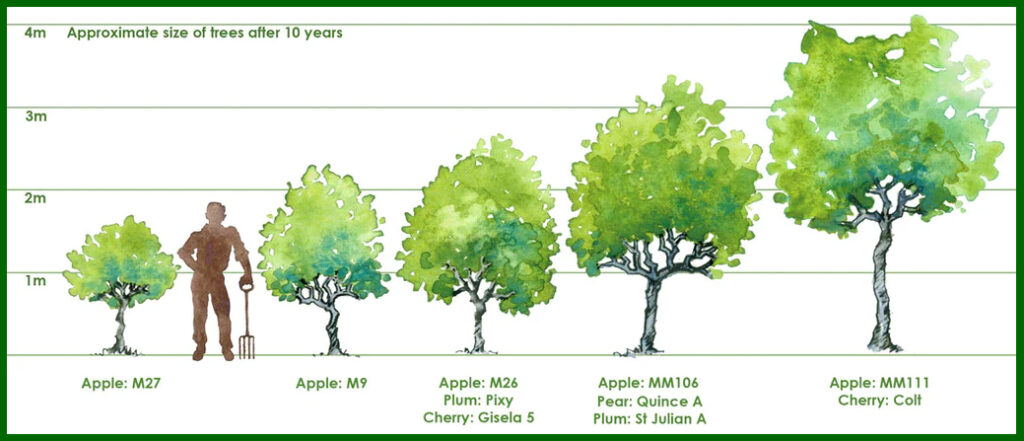
Apple: M27 Extremely dwarfing
Eventual height: 1.2 -1.8 mtrs x 1.5 mtrs spread
Spacing: 1.2-1.5 mtrs apart with 1.8mtrs between rows
Fruiting age: 2 years onwards
Suitable for: Dwarf pyramids, stepovers, small bush.
Requirements: Must have good fertile soil, must be weed and grass free and be permanently staked.Fruits early and at a good size for kids, suitable where space is very limited. Will grow in a pot.
Apple: M26 Dwarfing
Eventual height: 2.4 – 3 mtrs x 3.6mtrs spread
Spacing: 2.4-3.6mtrs with 4.5mtrs between rows
Fruiting age: 3 years onwards
Suitable for: Bush, pyramid, cordon, espalier.
Requirements: Average good soil, not very heavy soils, stake for the first 4 years or so.A good rootstock for training forms and a nice sized tree.
Apple: MM106 Semi dwarfing
Eventual height: 3 – 4 m x 4 m spread.
Spacing: 3.6 m with 4.5 m between the rows.
Fruiting age: 3 to 4 years onwards.
Suitable for: Bush, pyramid, espalier.
Requirements: Will grow in a wide range of soils including grass lands and poor soils. The most widely used rootstock, not suitable for very small gardens, but the best choice if you feel conditions are not ideal. A productive tree. Will need staking for the first 4 years or so.
Apple: MM111 Vigorous
Eventual height:4 – 4.5 mtrs x 4.5 mtrs spread.
Spacing: 4.5 mtrs apart with 6 mtrs between rows.
Fruiting age: 5 to 6 years onwards.
Suitable for: Large orchard tree
Requirements: Suitable for most soils including grasslands and poor soils. Large tree, long lived only suitable for big gardens, orchards or open areas. Will need a stake for the first few years.If you want a large growing tree and your soil is not great, this is the rootstock for you.
Apple
Additional Information
These are the most commonly used apple rootstocks in Ireland and the UK:
M25 Very Vigorous
M2 Vigorous
M111 Vigorous, high tolerance of waterlogging
MM106 Semi Vigorous
M116 Slightly less vigorous than MM106, disease resistant
M26 Semi Dwarfing
M9 Dwarfing
M27 Ultra Dwarfing
Another diagram of rootstocks

Pear
Pear: Quince A Semi Dwarfing
Eventual height: 3 – 4.5mtrs
Spacing: 3-4.5mtrs.
Fruiting age: From 4 years onwards.
Suitable for: Fan, cordon, bush, central leader, half-standard, espalier
Requirements: A sunny site with good fertile soil, not very heavy soils, needs staking for the first 4 years or so.
Additional Information
Pear rootstocks (also suitable for quince and medlar)
Pyrus communis Very vigorous
Pyrus Kirchensaller Very vigorous (crops more consistant than Pyrus communis)
Pyrodwarf Vigorous
Quince BA29 Semi Vigorous (smaller than Pyrodwarf)
Quince A Slightly Vigorous
Quince EMH (Dwarfing but better fruit size than Quince C)
Quince C Dwarfing
Plum
Plum: Pixy Semi dwarfing
Eventual height: 2.5 – 3.5 mtrs
Spacing: 3.5 – 4 mtrs.
Fruiting age: From 3 or 4 years onwards.
Suitable for: Cordon, dwarf bush.
Requirements: Requires good fertile soil, kept weed and grass free, needs permanent staking.
Plum : St Julian A Semi vigorous
Eventual height: 3.5 – 4.5 mtrs
Spacing: 5 mtrs
Fruiting age: From 3 or 4 years onwards.
Suitable for: Bush, half standard, fan-trained.
Requirements: The most widely used rootstock, will grow in a wide range of soils and can tolerate some heavy soils.
Additional Information
Myrobalan B Very Vigorous
Brompton Vigorous.
St Julien A Semi Vigorous
Jaspi Semi Vigorous but with greater tolerance of wet situations
Plumina (Ferlenain) Similar vigour to Pixy but improved fruit size.
Pixy Semi Dwarfing
Cherry
Cherry: Colt Semi vigorous
Eventual height: 4 – 5 mtrs
Spacing: 5 – 6 mtrs
Fruiting age: From 3 or 4 years onwards.
Suitable for: Bush, half standard, fans
Requirements:Suitable for a wide range of soils and can tolerate some heavy soils, stake for the first few years.
Cherry: Gisela 5 Semi dwarfing
Eventual height: 2.5 – 3 mtrs
Spacing: 2.5 – 3 mtrs
Fruiting age: From 3 or 4 years onwards.
Suitable for: Bush, fan
Requirements: Must be good fertile soil, must be weed and grass free and permanently staked.
Additional Information
F.12.1 (Mazzard) Very Vigorous
Mahaleb Vigorous
MxM14 Semi Vigorous
Colt Semi Vigorous
Gisela 6 Semi Dwarfing
Gisela 5 Dwarfing
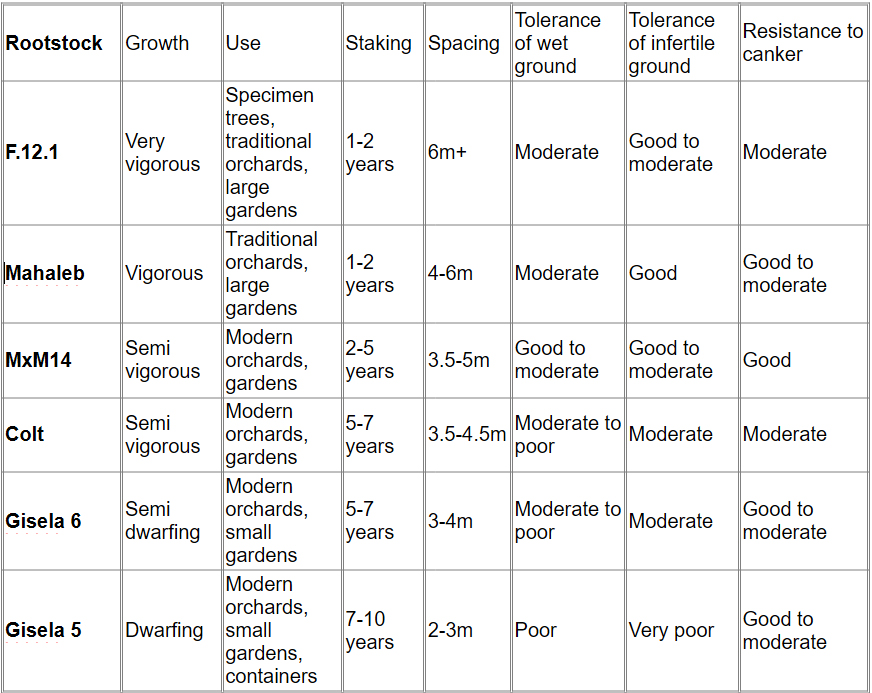
Sweet Chestnut
While some hybrid varieties of sweet chestnut are propagated by layering or stooling and grown on their own roots, most are grafted onto seed-grown rootstocks of Castanea sativa, Castanea crenata (the Japanese chestnut) or C.sativa x crenata hybrids . The latter offer a good combination of vigour, disease resistance and compatibility with most common chestnut cultivars.
The hybrid Marigoule is often used as rootstock, and produces a tree of good vigour. Other choices include Bournette, Bouch de Betizac, Maraval, Marlhac, Marsol, and Vignois. Trees grown on Marlhac or Vignois rootstocks may leaf out slightly later, which could be an advantage in regions at risk from late frosts.
Walnut
Walnut cultivars are most commonly grafted onto seed-grown Juglans regia. Occasionally Juglans nigra or Juglans hindsii rootstocks are used. However, walnuts grown on these rootstocks can develop black line, a graft incompatibility that only emerges after 15-20 years.
Rootstocks grown from Juglans regia seed of north-western European provenance are most likely to perform best in Ireland or Britain. The most important nut growing region within this area is the Dordogne in France. Walnuts are also produced commerically (albeit often on a small scale) in many parts of Germany, Alsace-Lorraine (France), southern England and the Netherlands.
Some work has been done on developing dwarfing walnut rootstocks in China, apparently with some degree of success. Although the use of interstitial grafts appears rare in walnuts, there may be scope for using interstices of naturally compact cultivars such as Rita to produce trees of less vigour.
The Nursery with the widest but limited quantity growing Walnuts in the UK is Warwickshire Walnuts & Trees
Click Image
Most of the information on this page supplied by
Future Forests
and by Ándi Wilson who died 4th of December 2020.
If you really want to know about Rootstocks here is a most exhaustive list but out of print.




